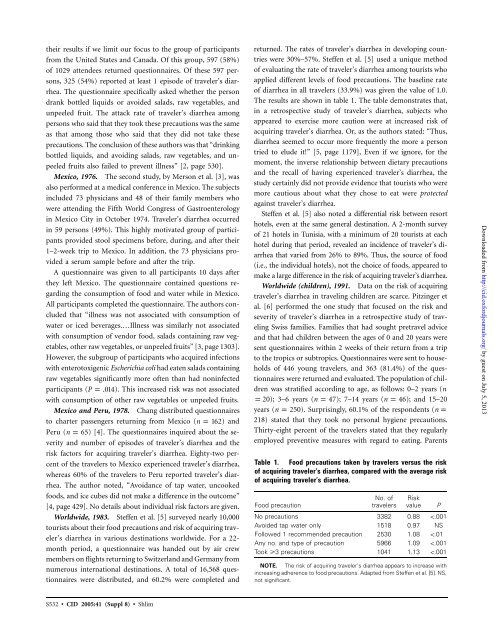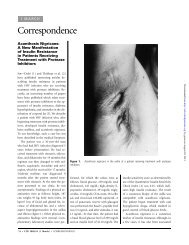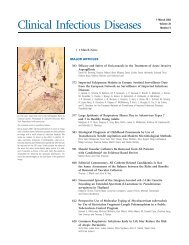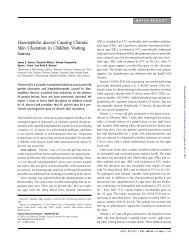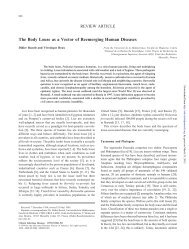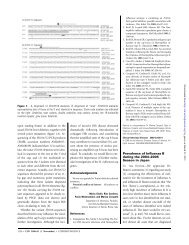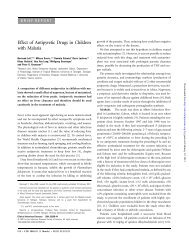Looking for Evidence that Personal Hygiene Precautions Prevent ...
Looking for Evidence that Personal Hygiene Precautions Prevent ...
Looking for Evidence that Personal Hygiene Precautions Prevent ...
Create successful ePaper yourself
Turn your PDF publications into a flip-book with our unique Google optimized e-Paper software.
their results if we limit our focus to the group of participants<br />
from the United States and Canada. Of this group, 597 (58%)<br />
of 1029 attendees returned questionnaires. Of these 597 persons,<br />
325 (54%) reported at least 1 episode of traveler’s diarrhea.<br />
The questionnaire specifically asked whether the person<br />
drank bottled liquids or avoided salads, raw vegetables, and<br />
unpeeled fruit. The attack rate of traveler’s diarrhea among<br />
persons who said <strong>that</strong> they took these precautions was the same<br />
as <strong>that</strong> among those who said <strong>that</strong> they did not take these<br />
precautions. The conclusion of these authors was <strong>that</strong> “drinking<br />
bottled liquids, and avoiding salads, raw vegetables, and unpeeled<br />
fruits also failed to prevent illness” [2, page 530].<br />
Mexico, 1976. The second study, by Merson et al. [3], was<br />
also per<strong>for</strong>med at a medical conference in Mexico. The subjects<br />
included 73 physicians and 48 of their family members who<br />
were attending the Fifth World Congress of Gastroenterology<br />
in Mexico City in October 1974. Traveler’s diarrhea occurred<br />
in 59 persons (49%). This highly motivated group of participants<br />
provided stool specimens be<strong>for</strong>e, during, and after their<br />
1–2-week trip to Mexico. In addition, the 73 physicians provided<br />
a serum sample be<strong>for</strong>e and after the trip.<br />
A questionnaire was given to all participants 10 days after<br />
they left Mexico. The questionnaire contained questions regarding<br />
the consumption of food and water while in Mexico.<br />
All participants completed the questionnaire. The authors concluded<br />
<strong>that</strong> “illness was not associated with consumption of<br />
water or iced beverages.…Illness was similarly not associated<br />
with consumption of vendor food, salads containing raw vegetables,<br />
other raw vegetables, or unpeeled fruits” [3, page 1303].<br />
However, the subgroup of participants who acquired infections<br />
with enterotoxigenic Escherichia coli had eaten salads containing<br />
raw vegetables significantly more often than had noninfected<br />
participants ( ). This increased risk was not associated<br />
P p .014<br />
with consumption of other raw vegetables or unpeeled fruits.<br />
Mexico and Peru, 1978. Chang distributed questionnaires<br />
to charter passengers returning from Mexico ( ) and<br />
n p 162<br />
Peru ( ) [4]. The questionnaires inquired about the sen<br />
p 65<br />
verity and number of episodes of traveler’s diarrhea and the<br />
risk factors <strong>for</strong> acquiring traveler’s diarrhea. Eighty-two percent<br />
of the travelers to Mexico experienced traveler’s diarrhea,<br />
whereas 60% of the travelers to Peru reported traveler’s diarrhea.<br />
The author noted, “Avoidance of tap water, uncooked<br />
foods, and ice cubes did not make a difference in the outcome”<br />
[4, page 429]. No details about individual risk factors are given.<br />
Worldwide, 1983. Steffen et al. [5] surveyed nearly 10,000<br />
tourists about their food precautions and risk of acquiring traveler’s<br />
diarrhea in various destinations worldwide. For a 22month<br />
period, a questionnaire was handed out by air crew<br />
members on flights returning to Switzerland and Germany from<br />
numerous international destinations. A total of 16,568 questionnaires<br />
were distributed, and 60.2% were completed and<br />
S532 • CID 2005:41 (Suppl 8) • Shlim<br />
returned. The rates of traveler’s diarrhea in developing countries<br />
were 30%–57%. Steffen et al. [5] used a unique method<br />
of evaluating the rate of traveler’s diarrhea among tourists who<br />
applied different levels of food precautions. The baseline rate<br />
of diarrhea in all travelers (33.9%) was given the value of 1.0.<br />
The results are shown in table 1. The table demonstrates <strong>that</strong>,<br />
in a retrospective study of traveler’s diarrhea, subjects who<br />
appeared to exercise more caution were at increased risk of<br />
acquiring traveler’s diarrhea. Or, as the authors stated: “Thus,<br />
diarrhea seemed to occur more frequently the more a person<br />
tried to elude it!” [5, page 1179], Even if we ignore, <strong>for</strong> the<br />
moment, the inverse relationship between dietary precautions<br />
and the recall of having experienced traveler’s diarrhea, the<br />
study certainly did not provide evidence <strong>that</strong> tourists who were<br />
more cautious about what they chose to eat were protected<br />
against traveler’s diarrhea.<br />
Steffen et al. [5] also noted a differential risk between resort<br />
hotels, even at the same general destination. A 2-month survey<br />
of 21 hotels in Tunisia, with a minimum of 20 tourists at each<br />
hotel during <strong>that</strong> period, revealed an incidence of traveler’s diarrhea<br />
<strong>that</strong> varied from 26% to 89%. Thus, the source of food<br />
(i.e., the individual hotels), not the choice of foods, appeared to<br />
make a large difference in the risk of acquiring traveler’s diarrhea.<br />
Worldwide (children), 1991. Data on the risk of acquiring<br />
traveler’s diarrhea in traveling children are scarce. Pitzinger et<br />
al. [6] per<strong>for</strong>med the one study <strong>that</strong> focused on the risk and<br />
severity of traveler’s diarrhea in a retrospective study of traveling<br />
Swiss families. Families <strong>that</strong> had sought pretravel advice<br />
and <strong>that</strong> had children between the ages of 0 and 20 years were<br />
sent questionnaires within 2 weeks of their return from a trip<br />
to the tropics or subtropics. Questionnaires were sent to households<br />
of 446 young travelers, and 363 (81.4%) of the questionnaires<br />
were returned and evaluated. The population of children<br />
was stratified according to age, as follows: 0–2 years (n<br />
p 20); 3–6 years ( n p 47); 7–14 years ( n p 46);<br />
and 15–20<br />
years ( n p 250).<br />
Surprisingly, 60.1% of the respondents (n p<br />
218) stated <strong>that</strong> they took no personal hygiene precautions.<br />
Thirty-eight percent of the travelers stated <strong>that</strong> they regularly<br />
employed preventive measures with regard to eating. Parents<br />
Table 1. Food precautions taken by travelers versus the risk<br />
of acquiring traveler’s diarrhea, compared with the average risk<br />
of acquiring traveler’s diarrhea.<br />
Food precaution<br />
No. of<br />
travelers<br />
Risk<br />
value P<br />
No precautions 3382 0.88 !.001<br />
Avoided tap water only 1518 0.97 NS<br />
Followed 1 recommended precaution 2530 1.08 !.01<br />
Any no. and type of precaution 5966 1.09 !.001<br />
Took 3 precautions 1041 1.13 !.001<br />
NOTE. The risk of acquiring traveler’s diarrhea appears to increase with<br />
increasing adherence to food precautions. Adapted from Steffen et al. [5]. NS,<br />
not significant.<br />
Downloaded from<br />
http://cid.ox<strong>for</strong>djournals.org/ by guest on July 5, 2013


